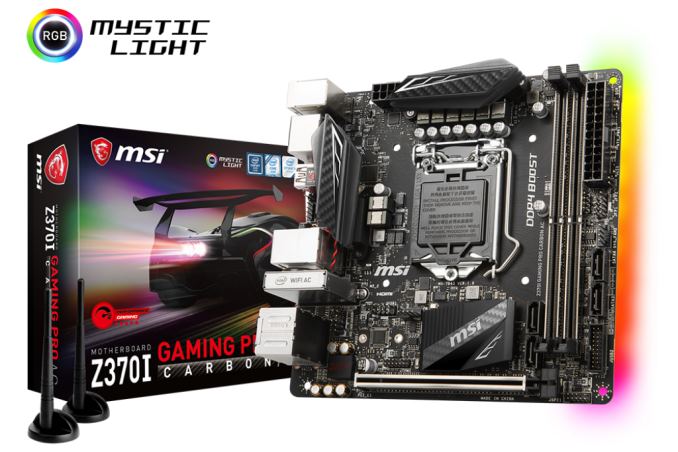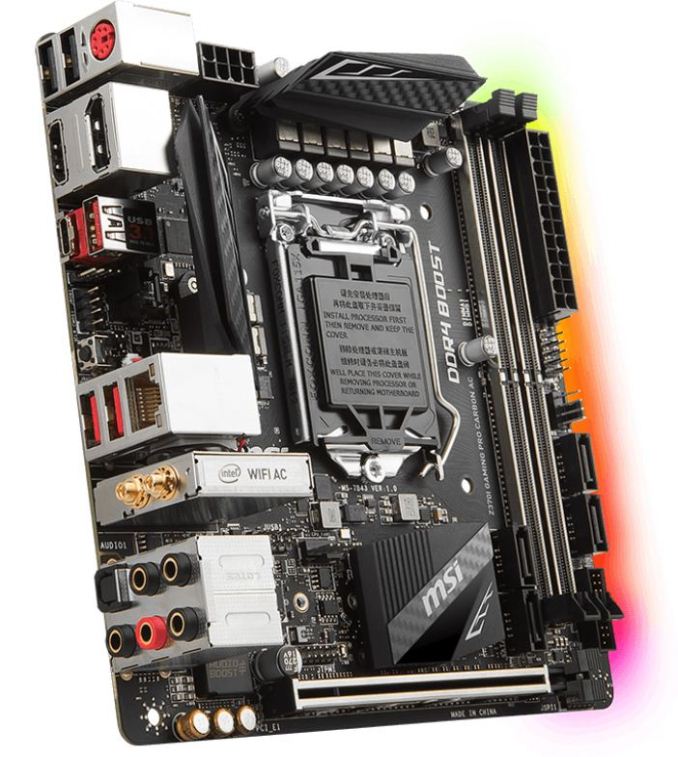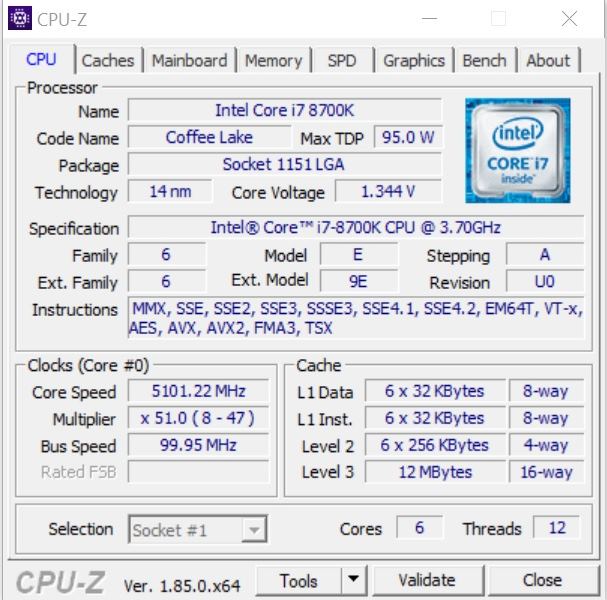The MSI Z370I Gaming Pro Carbon AC (mITX) Motherboard Review: Balanced Gaming Diet
by Joe Shields on August 23, 2018 8:00 AM EST- Posted in
- Motherboards
- Intel
- MSI
- Mini ITX
- Coffee Lake
- Z370

Today we're looking at one of MSI's Mini-ITX motherboards, the Z370I Gaming Pro Carbon AC. The Gaming Pro Carbon AC supports 8th Gen Intel Core Coffee Lake-based processors with DDR4 memory support up to DDR4-4600. The board includes the latest Realtek audio codec, along with Nahimic 2+ audio processing, Intel-based LAN and wireless, USB 3.1 ports out back, a well as a single M.2 drive. RGB is also in abundance, all in a Mini-ITX package.
AnandTech Intel 300-Series Motherboard and CPU Coverage
- The Intel Core i7-8086K Review: Testing Intel's Anniversary 5.0 GHz Turbo CPU
- The Anandtech Coffee Lake Review: Initial Numbers on the Core i7-8700K and Core i5-8400
- Analyzing Z370 for Intel's 8th Generation Coffee Lake: A Quick Look at 50+ Motherboards
- ($397) The ASUS ROG Maximus X Apex [LINK]
- ($250) The NZXT N7 Z370 [LINK]
- ($219) The ASRock Z370 Taichi [LINK]
- ($191) The SuperO C7Z370-CG-IW [LINK]
- ($180) The ASRock Z370 Gaming-ITX/ac [LINK]
- ($180) The ASUS Z370-I Gaming [LINK]
- ($168) The MSI Z370I Gaming Pro Carbon AC Review (this review)
- ($124) The GIGABYTE H370N WIFI [LINK]
- ($120) The GIGABYTE B360 Gaming 3 WIFI [LINK]
MSI Z370I Gaming Pro Carbon AC Overview
The Mini-ITX space of the mainstream Z370 platform typically attracts users who would like a powerful PC in a small package. Generally this includes those who would also like to take advantage of some of the Z-exclusive features, otherwise, there are H-series boards in this form factor that are usually less expensive and more cost-effective. Users are able to build a high-performance machine on this platform but with fewer cores and higher frequency.
With board partners always keeping their ear to the rails, all major board partners have at least one Mini-ITX offering. Buyers are always looking for a combination of performance, appearance, and feature set to help select the right board for their needs. The MSI Z370I Gaming Pro Cabon AC will support the flagship i7-8700K processor (with overclocking), has a single M.2 slot, Wi-Fi, RGB LEDs, all in a 6-inch square package.
Performance wise, the MSI Z370I Gaming Pro Carbon AC performed well in our testing suite, typically landing in a good average of the boards we have tested. Idle power use was average while load testing showed the board to use a few watts less than the other Z370 boards tested. Boot times were also quick with the Gaming Pro Carbon AC POSTing the 2nd fastest time. Overall, there was nothing out of line, including the gaming results, with performance testing.
Our overclocking results showed the small board did not have any issues reaching 5.1 GHz, which is where most all other boards topped out. We did need to raise the default power limits a bit early (4.5 GHz), but that is par for the course anyway. As with most overclocking endeavors on this platform, we are limited by cooling and not by the board. Delidding would drop temps on this sample and allow a push for 5.2 GHz and the board wouldn't mind a bit.
The Gaming Pro Carbon AC has a total of four SATA ports along with one M.2 slot. The four SATA ports support RAID 0, 1, 5, and 10 and do not share ports/bandwidth when an M.2 device is in use. The M.2 slot supports up to a 2280 size module as well as supporting both SATA and PCIe based devices.
The board has a single full-length PCIe slot and with this does not support SLI or Crossfire configurations (no details on lane bifurcation). Audio duties are handled by the latest Realtek ALC1220 codec along with MSI's supporting cast of hardware in Chemi-Con audio capacitors and a built-in dedicated headphone amplifier capable of supporting up to 600Ω cans.
The back panel IO is fairly devoid of most colors that are not black or red which fits MSI's Gaming theme but does little to visually separate the ports. That said, we are able to see a legacy PS/2 port for mouse and keyboard, two USB 2.0 ports, two USB 3.0 ports (red below the NIC), and two USB 3.1 ports (Type-A and Type-C). The board includes HDMI (1.4) and DisplayPort (1.2) connectivity used for the integrated GPU on the Coffe Lake CPUs. Next, we can see a simple CMOS reset button, the Wi-Fi stack, as well as a 5-jack audio stack and SPDIF connections. Overall, it covers the gamut well and should have plenty of ports for most users.
The price for the MSI Z370I Gaming Pro Carbon AC comes in at $168 (Amazon). That price point has it slotting in nicely between the other Mini-ITX sized boards. The ASUS ROG Strix Z370-I Gaming costs $179 (Newegg), the ASRock Fatality Z370 Gaming-ITX/ac $180, the SuperO C7Z370-CG-IW at $186, and the GIGABYTE Z370N WiFi at $150. The price point places it in the middle of its other Mini-ITX sized cousins and in the end, selecting an appropriate board will come down to the features, appearance, and cost, with few differences (M.2 slot count, USB support, etc) between them.
MSI Z370 Strategy
MSI brings a total of 13 motherboards to the table ranging in size from Mini-ITX to ATX and pricing starting off around $110 and ending up well over $200. MSI more than likely has a board for everyone here as they have the Enthusiast, Performance, and Arsenal Gaming lines represented well here along with a couple of options in the Pro Series. The flagship of them all is the Z370 Godlike Gaming which also happens to be a limited run board (no price as it is not found online) but there are many boards below it in the product stack that has the right features, look, and price tag for a wide range of users.













18 Comments
View All Comments
eek2121 - Thursday, August 23, 2018 - link
I would like to know how many people actually have multiple m.2 drives. I typically just install a single drive and if I need additional storage, fallback to SATA.I might have to pick up one of these and a Node 202 case or something for a small, compact gaming PC.
AdditionalPylons - Thursday, August 23, 2018 - link
I bought the ASRock AB350M Pro4 specifically because it had two M.2 slots. (One supporting both PCIe and S-ATA and the other one only S-ATA.) This allows for one very fast system and application drive and one bigger and cheaper as video editing scratch disk. This keeps the number of cables lower. Airflow can probably be debated because on one hand M.2 drives may not get much air, but on the other hand S-ATA PCBs are enclosed and don't get much airflow either.Price-wise M.2 S-ATA drives are almost the same as 2.5" S-ATA drives. I wouldn't be surprised if M.2 got cheaper than S-ATA over time due to the size of the enclosure and packaging, but it's more likely mostly due to supply and demand.
katsetus - Thursday, August 23, 2018 - link
In case of Node 202, the other m.2 slot would come in handy for expansion. I have the Asus z370i strix in it, and with a large gpu and non-modular psu, the hdd bracket would be a nuisance, and I am unsure if it would even fit. With storage-oriented (as compared to performance-oriented) nvme drives coming down in price, I would consider buying another nvme drive for expanded storage rather than a 2.5 inch ssd. At least in case of Node 202, that is.Hxx - Thursday, August 23, 2018 - link
m.2 drives have come down in price especially if you're going for a SATA m.2. Much more elegant, no cable clutter, and generally faster for a small price premiumDanNeely - Thursday, August 23, 2018 - link
For people going with even smaller new SFF cases than you're co, there might not even be an HDD bay at all making it m.2 or MacGyver for solid state drives.Gothmoth - Friday, August 24, 2018 - link
i have 3 x 1TB drives. in my TR system.Dug - Sunday, August 26, 2018 - link
I use 2 m.2 drives and wish I could use three, but there would be a performance hit for doing so.1 for OS and all apps. 2nd for games and editing files. Sata drive for back up and photos.
NobodyYouKnow - Wednesday, August 29, 2018 - link
I currently use 3 M.2 cards (2x PCIe M.2 & 1x Sata M.2) on the MSI Z370 Gaming Pro Carbon. Got 1 PCIe M.2 in the top slot, the sata M.2 in the bottom, and an older PCIe M.2 in a M.2 PCIe x4 add-in adapter card (Akasa AK-PCCM2P-01). The latter is in the bottom PCIe x8 slot.The plan is to buy a 1TB PCIe M.2 that will go in the bottom M.2 slot and move the sata M.2 in the Akasa adapter. The card currently in the adapter is not enough for my games but will work just fine in a htpc.
prateekprakash - Thursday, August 23, 2018 - link
One query: is it possible to connect multiple headphones using the back audio jacks? ( Without using any splitter or external DAC, just those 3.5mm ports)I just need stereo audio through each headphones, nothing fancy...
DanNeely - Thursday, August 23, 2018 - link
AFAIK no boards support this unless you've got a pair that can connect over the optical port (do these exist?). The various analog pins are to support separate location channels for surround sound, so if you plug in multiple headphones the audio controller will think you've got front, and center, or side, or etc speakers.